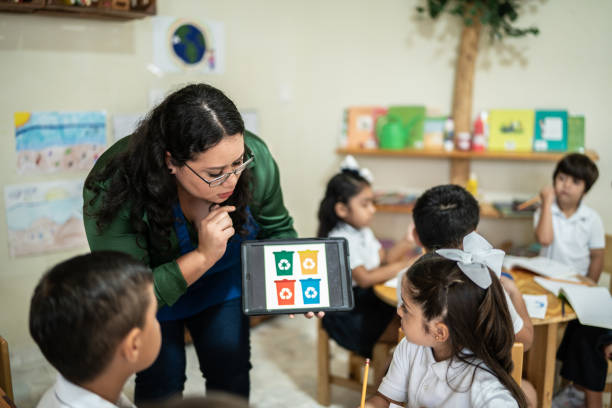Our planet faces an urgent and complex environmental crisis today. Climate change, pollution, and resource depletion are becoming increasingly critical, requiring comprehensive environmental education. Zero-waste schools are powerful tools in this regard, as they equip students with the knowledge and skills to actively participate in the mitigation of these problems.
Incorporating zero-waste principles into the school curriculum exposes students to the environmental impacts of waste. This awareness is crucial for fostering a generation that is not only knowledgeable about environmental issues but also motivated to seek and implement solutions.
Zero-waste schools also help students grasp the concept of the circular economy, where we efficiently use resources and reduce waste. Developing this understanding is critical to driving systemic change and promoting sustainable practices.
The Importance of Instilling Sustainable Habits Early On
To foster long-term behavioral change, zero waste schools need to instill sustainable habits early in life. From an early age, students learn the importance of reducing, reusing, and recycling. A lifetime of environmental stewardship begins with early environmental education.
Educating students about zero-waste encourages them to think critically about consumption patterns and product lifecycles. During activities that illustrate the journey from production to disposal of plastic bottles, students may consider alternatives such as reusable water bottles. Both at home and at school, students are more likely to adopt sustainable habits when they understand the environmental costs of their choices.
Besides individual actions, zero-waste education fosters a culture of communal responsibility. Organizing school-wide recycling programs or maintaining compost bins shows students the value of working together. In addition to reinforcing sustainable habits, these experiences build a sense of community and purpose.
A zero-waste education can have a significant impact on the next generation’s behavior and mindset. Students get practical skills to address environmental challenges through this proactive approach. For a greener and more sustainable future, it is imperative to cultivate environmentally conscious individuals by instilling sustainable habits early on through zero-waste education.
Key Principles of Zero-Waste Schools
Reducing, reusing, and recycling are the cornerstones of zero-waste education. In any zero-waste curriculum, these principles are at the heart of the sustainable lifestyle.
Reducing:
We can reduce waste by minimizing the amount of resources we consume and the amount of waste we produce. Schools can teach this through practices such as:
- Encouraging digital homework and assignments to cut down on paper use.
- Promoting the use of durable, long-lasting school supplies instead of single-use items.
- Teaching students about mindful consumption, helping them to make choices that minimize waste, such as choosing products with minimal packaging or buying in bulk.
Reusing:
Reusing involves finding new ways to use items that might otherwise be thrown away. Schools can foster a culture of reusing through:
- Organizing swap events where students can exchange books, clothes, and other items.
- Encouraging creative projects that repurpose materials, like using old jars for storage or making art from recycled materials.
- Implementing a second-hand supply closet where students can donate and borrow school supplies.
Recycling:
The process of recycling involves converting waste into new, usable materials. Despite its importance, recycling should be viewed as a last resort after reducing and reusing waste. Education about recycling should include:
- Teaching students the correct way to sort recyclables and the importance of cleaning materials before recycling.
- Setting up and maintaining accessible recycling bins throughout the school.
- Educating about the limitations of recycling and the importance of reducing and reusing to prevent waste in the first place.
Emphasizing Circular Economy Concepts
Zero-waste schools also emphasize the importance of the circular economy, a systemic approach to economic development designed to benefit businesses, society, and the environment. In contrast to the linear economy, which takes, makes, and disposes of, the circular economy aims to maximize value from resources, and recover and regenerate products and materials at the end of their useful lives.
Students should learn the fundamental principles of the circular economy, including:
- Designing for longevity: Products should be designed to last, be easily repaired, and eventually recycled.
- Keeping products and materials in use: Encouraging practices like sharing, leasing, reusing, repairing, and refurbishing to extend the lifecycle of products.
- Regenerating natural systems: Ensuring that any waste we produce can be returned safely to the environment, for example through composting organic waste to enrich soil.
To bring these concepts to life, schools can:
- Introduce projects that highlight circular economy practices, such as creating a school garden that uses composted food waste or a repair cafe where students can learn to fix broken items.
- Partner with local businesses and organizations that exemplify circular economy principles, providing students with real-world examples and potential career paths.
- Encourage innovation and problem-solving by challenging students to redesign everyday products or systems to be more sustainable and circular.
Creating a Sustainable Curriculum in Zero-Waste Schools
1. Science and Sustainability
Teaching students about sustainability and zero-waste practices through science education is a natural and effective way to teach them about the environment. Among the most important strategies are:
- Ecology and Ecosystems: Teach students about different ecosystems and the impact of waste on these natural environments. This can include lessons on pollution, climate change, and the importance of biodiversity.
- Renewable Energy: Explore different types of renewable energy sources, such as solar, wind, and hydroelectric power, and how they reduce waste and pollution compared to fossil fuels.
- Waste Decomposition: Conduct experiments to show how different materials decompose over time. This can help students understand the long-term impacts of waste on the environment and the importance of choosing biodegradable and recyclable materials.
- Sustainable Practices in Lab Work: Encourage the use of sustainable materials and practices in science labs, such as reducing the use of single-use plastics and properly disposing of chemicals.
2. Literature and Environmental Themes
By integrating environmental themes into literature classes, students can gain a deeper understanding of sustainability and be inspired. Here’s how:
- Eco-Literature: Introduce students to novels, poems, and essays that focus on nature, the environment, and sustainability. Works by authors such as Henry David Thoreau, Rachel Carson, and Barbara Kingsolver can provide profound insights into the relationship between humans and the environment.
- Environmental Writing Projects: Encourage students to write their own stories, poems, or essays about environmental issues. This can help them express their understanding of zero-waste concepts and their feelings about the importance of sustainability.
- Discussion and Debate: Use literature as a springboard for discussions and debates on environmental issues. This can help students develop critical thinking skills and understand different perspectives on sustainability.
3. Math and Resource Management
Mathematics provides essential tools for understanding and managing resources efficiently. Here’s how math can be integrated into a zero-waste curriculum:
- Data Analysis: Teach students how to collect and analyze data related to waste production and recycling rates. This can involve creating graphs, charts, and statistics to understand trends and identify areas for improvement.
- Resource Efficiency Calculations: Use math to calculate the efficiency of resource use in various contexts. For example, students can compare the energy consumption of different types of light bulbs or the water usage of various appliances.
- Budgeting for Sustainability: Incorporate lessons on financial literacy that focus on budgeting for sustainable practices. This can include calculating the cost savings of reducing waste, using renewable energy, or buying in bulk.
- Problem-Solving Projects: Assign projects that require students to solve real-world problems using math. For instance, they could design a waste reduction plan for the school or create a model for a sustainable community.
Hands-On Learning and Student Involvement
1. School Gardens
The school garden is an excellent way for students to learn about sustainability and zero-waste practices through hands-on experience. Students can see the principles of ecology and resource management in action in their living classrooms.
- Planting and Growing: Students can learn about plant life cycles, the importance of biodiversity, and sustainable farming practices. They can participate in planting, maintaining, and harvesting crops, which teaches them patience, responsibility, and the value of hard work.
- Integrating Curriculum: Teachers can integrate garden activities with subjects like science (studying plant biology and soil chemistry), math (measuring plant growth, calculating area for planting), and even art (sketching plants and garden layouts).
2. Composting Projects
Composting projects are practical and educational, demonstrating the transformation of organic waste into valuable compost that enriches soil and reduces landfill waste.
- Setting Up Compost Bins: Students can be involved in setting up and maintaining compost bins. They can learn about the different types of composting, such as aerobic and vermicomposting, and the materials needed for each.
- Monitoring and Managing: Students can take turns managing the compost, which includes adding new material, turning the compost, and monitoring the temperature and moisture levels.
- Using the Compost: Once the compost is ready, students can use it in the school garden or donate it to local community gardens. This full-cycle experience shows students the tangible benefits of composting and how it contributes to a zero-waste system.
3. Waste Audits
Conducting waste audits is a powerful educational tool that involves students in identifying and analyzing the types and amounts of waste their school produces. This hands-on activity can provide valuable insights and motivate students to implement effective waste reduction strategies.
- Collecting Data: Students can collect and sort waste from different areas of the school (classrooms, cafeterias, offices). They can categorize the waste into types, such as paper, plastic, organic, and electronic waste.
- Analyzing Results: After collecting the data, students can analyze it to understand the major sources of waste and identify patterns. They can use graphs and charts to visualize their findings and present them to the school community.
- Identifying Solutions: Based on their analysis, students can propose solutions to reduce waste. This might include recommendations for increasing recycling bins or reducing single-use items.
4. Reduction Strategies
Developing and implementing waste reduction strategies empowers students to make a tangible difference in their school’s sustainability efforts.
- Reducing Single-Use Plastics: Encourage students to campaign for the reduction of single-use plastics by promoting alternatives such as reusable bottles, containers, and utensils. They can create posters, host workshops, and lead by example.
- Recycling Programs: Students can help enhance or set up recycling programs, ensuring that bins are correctly labeled and placed in convenient locations. They can also educate their peers about what can and cannot be recycled.
- Reuse Initiatives: Implement programs that encourage reusing materials. Establish a school exchange where students can exchange gently used materials like notebooks, binders, and art supplies.
- Educational Campaigns: Students can design campaigns to raise awareness about waste reduction. The school community can be informed about waste reduction through presentations, social media campaigns, and educational materials.
Choosing Zero-Waste School Supplies
1. Refillable Pens and Pencils
- Refillable Pens and Pencils: Refillable pens and mechanical pencils reduce plastic waste and minimize the need to replace them constantly. Their longer lifespan and refillability make them more sustainable.
- Popular Brands: A list of popular brands that offer high-quality refillable pens and pencils can help students and parents make informed decisions. Products made from recycled materials or those designed for long-term use could be recommended.
- Encouraging Care and Maintenance: The proper care of refillable pens and pencils fosters a sense of responsibility and a mindful use of resources.
2. Recycled Paper Products
- Types of Recycled Paper: Different types of recycled paper are available, such as notebooks, loose-leaf paper, and printer paper. Reduce deforestation and conserve water and energy by using recycled paper.
- Certifications to Look For: The FSC (Forest Stewardship Council) and PCW (Post-Consumer Waste) certifications can be used to identify truly sustainable products.
- Paper Use Reduction Tips: Use scrap paper for notes, print double-sided when possible, and use digital alternatives whenever possible to reduce paper consumption.
3. Durable and Reusable Options
- Selecting Durable Backpacks: Consider backpacks made from organic cotton, recycled polyester, or other eco-friendly materials. Reduce the need for frequent replacements by emphasizing durability.
- Features to Look For: Students will benefit from backpacks that have reinforced stitching, multiple compartments for organization, and ergonomic designs that meet their needs while being environmentally friendly.
- Reusable Lunchboxes: Stainless steel, silicone, and BPA-free plastic lunchboxes are great reusable options. Use these options to reduce disposable lunch packaging.
4. BPA-Free and Non-Toxic Materials
- Understanding BPA and its Alternatives: To prevent harmful chemicals from leaching into food and beverages, it is crucial to choose BPA-free products. BPA-free plastics, stainless steel, and glass are among the safer alternatives.
- Non-Toxic School Supplies: Lunchboxes, water bottles, and food containers should be non-toxic. To guide purchasing decisions, highlight brands that prioritize health and sustainability.
Encouraging Sustainable Transportation
- Developing Safe Pathways:
Develop safe, accessible routes for students who walk or bike to school in collaboration with local authorities. It may be necessary to add crosswalks, bike lanes, and traffic calming measures to the area.
- Walking and Biking Maps:
Map out the safest routes to school for students and parents. As part of these maps, crossing guards, bike racks, and designated drop-off points can be included.
- Walking School Buses and Bike Trains:
Volunteers or school staff can supervise groups of students walking or biking to school together. Community is fostered and safety is promoted by numbers.
- Reward Programs:
Reward students for walking, biking, or carpooling with reward programs. Students who consistently use sustainable transportation can receive incentives such as stickers, certificates, or entries into prize drawings.
- Recognition and Awards:
The use of sustainable transportation methods by students and their families should be highlighted. Using school newsletters, assemblies, or social media, acknowledge their efforts to inspire others.
- Challenges and Competitions:
Challenge your classes or grades to see who can walk, bike, or carpool the most miles in a month. Offer prizes or special privileges to the winning group.
How to Become a Zero-Waste School
1. Conducting a Waste Audit
- Comprehensive Waste Assessment: Conduct a thorough assessment of the school’s waste streams, including classrooms, cafeterias, offices, and outdoor areas. This helps identify the main sources of waste and the types of materials being discarded.
- Categorizing Waste: Sort the collected waste into categories such as paper, plastic, food waste, electronics, and other materials. This categorization provides a clear picture of where the most significant waste reductions can be made.
- Engaging Students and Staff: Involve students and staff in the waste audit process to raise awareness and encourage participation. This hands-on activity can also serve as an educational tool to demonstrate the importance of waste reduction.
2. Analyzing Current Waste Management Practices
- Evaluating Existing Programs: Review the current waste management practices. Identify any gaps or inefficiencies in these programs.
- Assessing Infrastructure: Check the availability and placement of recycling bins, composting facilities, and waste collection points. Ensure that these facilities are accessible and adequately labeled.
- Surveying Stakeholders: Collect feedback from students, teachers, and custodial staff about their experiences and challenges with the existing waste management system. This input can provide valuable insights for improvement.
3. Develop a Zero-Waste Action Plan
- Specific Targets: Set specific, measurable goals for waste reduction. Examples include reducing landfill waste by 50% within a year or increasing the recycling rate by 30%.
- Realistic Milestones: Establish realistic milestones that you can achieve in the short term.
- Long-Term Vision: Develop a long-term vision for the school’s zero-waste journey, with ambitious but attainable goals that can guide future initiatives and improvements.
4. Engaging Stakeholders and Building Consensus
- Forming a Zero-Waste Committee: Create a committee comprising students, teachers, administrative staff, and custodians to lead the zero-waste initiatives. This committee can coordinate efforts, monitor progress, and ensure awareness.
- Stakeholder Meetings: Hold regular meetings with stakeholders to discuss the action plan, gather feedback, and build consensus. Transparency and collaboration are key to gaining widespread support.
- Educational Campaigns: Launch educational campaigns to inform the school community about the zero-waste goals and how they can contribute. Use posters, assemblies, and digital communication to spread the message.
5. Starting Small
- Pilot Projects: Begin with pilot projects in specific areas of the school. These small-scale initiatives can demonstrate success and build momentum.
- Measuring Success: Track the progress and outcomes of pilot programs to measure their success. Use this data to make informed decisions about expanding these initiatives.
- Celebrating Achievements: Recognize and celebrate the successes of pilot programs to maintain enthusiasm and encourage further participation.
6. Scaling Up Successful Practices
- Expanding Programs: Once pilot programs have proven successful, expand them to other areas of the school.
- Continuous Improvement: Continuously seek ways to improve and optimize zero-waste practices. Encourage feedback and suggestions from the school community to identify new opportunities for waste reduction.
7. Regularly Review Progress
- Ongoing Monitoring: Establish a system for regularly monitoring and reviewing the progress of zero-waste initiatives. This can include monthly waste audits, surveys, and feedback sessions.
- Review Data: Analyze the collected data to track improvements, identify challenges, and measure the impact of implemented strategies. Use this analysis to inform future actions and adjustments.
- Reporting Results: Share the results of waste reduction efforts with the school community. Transparency about progress and challenges helps maintain accountability and engagement.
8. Adapting to New Challenges and Opportunities
- Flexibility: When new challenges or opportunities arise, adapt your strategies accordingly. Follow the latest developments in waste management and sustainability.
- Continuous Learning: Attend workshops, and conferences, and network with other zero-waste schools to encourage continuous learning and improvement. Keep up with best practices and innovative solutions.
- Celebrating Milestones: To keep the school community motivated and committed to the zero-waste journey, celebrate milestones and achievements. Individuals and groups who have made significant contributions should be recognized.
Conclusion
The journey towards zero-waste schools is not just about reducing waste; it’s about transforming mindsets and shaping a sustainable future. By embracing zero-waste principles, schools play a pivotal role in nurturing environmentally conscious students who are empowered to become leaders in sustainability.
Zero-waste schools are not just a concept but a reality that can be achieved through dedication, collaboration, and innovative strategies. The long-term impact of zero-waste education extends beyond the classroom, preparing students to be future environmental leaders and fostering a culture of sustainability within communities.
Let’s embrace the challenge of zero waste schools as an opportunity to inspire positive change, cultivate sustainable habits, and leave a lasting impact on both students and the environment. Together, we can build a greener, cleaner, and more sustainable future for all.







